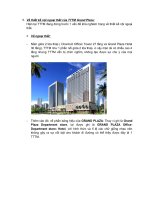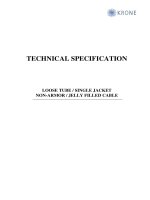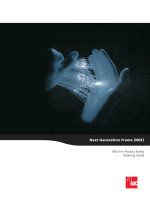Grand rounds MM
Bạn đang xem bản rút gọn của tài liệu. Xem và tải ngay bản đầy đủ của tài liệu tại đây (1.52 MB, 61 trang )
Please note, these are the actual
video-recorded proceedings from the
live CME event and may include the use of trade names and other raw, unedited
content.
Second Opinion: New Agents and
Emerging Trial Data in the Management
of Multiple Myeloma
Noopur Raje, MD
Director, Center for Multiple Myeloma
Massachusetts General Hospital Cancer Center
Associate Professor of Medicine
Harvard Medical School
Boston, Massachusetts
Disclosures
Advisory Committee
Consulting Agreements
Contracted Research
Amgen Inc, Bristol-Myers Squibb Company, Celgene Corporation, Novartis
Pharmaceuticals Corporation, Roche Laboratories Inc, Takeda Oncology
Amgen Inc, Bristol-Myers Squibb Company, Celgene Corporation, Novartis
Pharmaceuticals Corporation, Takeda Oncology
AstraZeneca Pharmaceuticals LP, Lilly
Grand Rounds Program Steering Committee
Morie A Gertz, MD, MACP
Joseph Mikhael, MD, MEd
Roland Seidler Jr Professor of the Art of Medicine
Professor of Medicine
Chair, Department of Medicine
Mayo College of Medicine
Mayo Distinguished Physician Mayo Clinic Rochester
Associate Dean, Mayo School
Rochester, Minnesota
of Graduate Medical Education
Deputy Director – Education
Mayo Clinic Cancer Center
Mayo Clinic in Arizona
Phoenix, Arizona
Jonathan L Kaufman, MD
Nikhil C Munshi, MD
Associate Professor of
Professor of Medicine
Hematology and Medical Oncology
Harvard Medical School
Winship Cancer Institute of
Director of Basic and Correlative Science
Emory University
Associate Director, Jerome Lipper Multiple Myeloma Center
Atlanta, Georgia
Department of Medical Oncology Dana-Farber Cancer Institute
Boston, Massachusetts
Grand Rounds Program Steering Committee
Noopur Raje, MD
Jeffrey A Zonder, MD
Director, Center for Multiple Myeloma, Massachusetts General
Professor of Oncology
Hospital Cancer Center
Karmanos Cancer Institute
Associate Professor of Medicine Harvard Medical School
Wayne State University
Boston, Massachusetts
Detroit, Michigan
Jeffrey L Wolf, MD
Project Chair
Professor of Medicine
Neil Love, MD
Director, Myeloma Program
Research To Practice
Division of Hematology/Oncology
Miami, Florida
Blood and Marrow Transplantation
University of California, San Francisco
San Francisco, California
New Agents and Emerging Trial Data in the Management of Multiple Myeloma
Module 1: Induction and Maintenance Therapy for Newly
Diagnosed MM
Module 2: Management of Relapsed/Refractory Disease
Module 3: Integrating Newly Approved Agents into Clinical Practice
•
•
•
•
Ixazomib (Tourmaline-MM1)
Daratumumab (GEN501, Sirius)
Elotuzumab (ELOQUENT-2)
Panobinostat (PANORAMA1)
Module 4: Investigational Immunotherapy Strategies
An otherwise healthy 60-year-old patient presents with ISS Stage II multiple myeloma (MM). Cytogenetics and FISH reveal no high-risk
features. In general, which induction treatment would you most likely recommend?
What are your thoughts about autologous stem cell transplant (ASCT)?
INDUCTION
ASCT
RVd
Recommend
RVd
Recommend
RVd
Recommend but willing to delay
RVd
Recommend
RVd
Recommend
RVd
Recommend
RVd
Recommend but willing to delay
R = lenalidomide; V = bortezomib; d = dexamethasone
Treatment Sequence in Myeloma
Bortezomib
Lenalidomide
Thalidomide
VD
Now
Rev/Dex
CyBorD
Nothing
SCT
Thalidomide?
Bortezomib
VTD
Lenalidomide
VRD
Carfilzomib
Pomalidomide
Panobinostat
Daratumumab
Ixazomib
Elotuzumab
Front-line treatment
Induction
New
Consolidation
Maintenance
Postconsolidation
Relapsed disease
Rescue
Oprozomib
Carfilzomib combos
“More induction”
Lenalidomide 2 months
? Ixazomib
Isatuximab
Bendamustine
PD/PD-L1 inhibition
++++++++
Autologous Transplantation for Multiple Myeloma in the Era of New Drugs: A
Phase III Study of the Intergroupe Francophone Du Myelome (IFM/DFCI 2009
Trial)
Attal M et al.
Proc ASH 2015;Abstract 391.
IFM/DFCI 2009: A Phase III Study of RVD ± ASCT in Newly Diagnosed Multiple Myeloma
(NDMM)
RVD cycles 2, 3
PBSC collection
Eligibility (N = 700)
•
•
•
Cyclophosphamide + G-CSF
1:1
≤65 years old
Symptomatic NDMM
Treated with 1 cycle of RVD
RVD cycles 4-8
maintenance
R
10-15 mg/d
RVD cycles 2,3
PBSC collection
Cyclophosphamide + G-CSF
ASCT with MEL200
RVD cycles 4, 5
Primary endpoint: Progression-free survival
Attal M et al. Proc ASH 2015;Abstract 391.
Lenalidomide
x 12 mo
IFM/DFCI 2009: Response and Survival Analyses
RVD ASCT
RVD
(n = 350)
(n = 350)
61%
48%
3-year PFS*
HR = 1.5, p < 0.0002
Complete response (CR)
58%
46%
p < 0.001
* Benefit observed was uniform across all the following subgroups:
•
•
•
•
•
•
Age (≤ or >60 years)
Sex
Ig isotype (IgG or others)
ISS stage (I or II or III)
Cytogenetics (standard or high risk)
Response after the first 3 cycles of RVD (CR or not)
The ongoing Phase III DETERMINATION trial (DFCI 10-106) is the parallel US trial and will continue maintenance lenalidomide until disease
progression.
Attal M et al. Proc ASH 2015;Abstract 391.
Getting to Minimal Residual Disease (MRD)
Newly diagnosed
1×10
S.S. Patient
Disease burden
CR
1×10
Stringent CR
1×10
Molecular/Flow CR
?Cure?
0.0
4
8
12
Predictive Value of MRD by Next-Generation Sequencing (NGS) in the IFM/DFCI 2009 Trial
•
Bone marrow MRD evaluation before and after maintenance therapy in patients with very good partial response (VGPR) or better
•
MRD assessment by flow cytometry (FCM) and NGS
•
Prediction of PFS by MRD status as determined by NGS
•
Comparison of MRD sensitivity of NGS and FCM
−
-4
-6
Sensitivity: FCM = 10 ; NGS = 10
−
Of 163 patients MRD-negative by FCM, 84 (51%) were positive by NGS
Three-year PFS for patients achieving complete response
-6
MRD-negative by NGS (<10 )
-6
MRD-positive by NGS (≥10 )
p-value
Before maintenance
87%
63%
0.0075
After maintenance
92%
64%
<0.0001
Avet-Loiseau H et al. Proc ASH 2015;Abstract 191.
Bortezomib, Lenalidomide and Dexamethasone vs Lenalidomide and
Dexamethasone in Patients with Previously Untreated Multiple Myeloma
without an Intent for Immediate Autologous Stem Cell Transplant: Results of
the Randomized Phase III Trial SWOG S0777
Durie B et al.
Proc ASH 2015;Abstract 25.
SWOG S0777: A Phase III Trial of RVd
versus Rd in NDMM
RVd
8 cycles of 21 days each
Eligibility (N = 525)
•
•
Rd maintenance
Previously untreated NDMM
Immediate ASCT not intended
until toxicity or
R
withdrawal
Rd
6 cycles of 28 days each
Primary endpoint: Progression-free survival
Durie B et al. Proc ASH 2015;Abstract 25.
Survival Analyses
PFS
OS
100%
100%
80%
80%
60%
60%
40%
HR = 0.712 (0.560, 0.906)*
Rd
40%
RVd
20%
RVd
20%
Rd
HR = 0.709 (0.516, 0.973)*
Log-rank P value = 0.0250 (two sided)*
Log-rank P value = 0.0018 (one sided)*
0%
0%
0
24
48
72
96
0
24
Months from Registration
48
72
96
Months from Registration
* Stratified
Median PFS
RVd
Rd
(n = 242)
(n = 229)
HR
p-value
43 mo
30 mo
0.712
0.0018
Durie B et al. Proc ASH 2015;Abstract 25.
One-sided
Median OS
RVd
Rd
Two-sided
(n = 242)
(n = 229)
HR
p-value
75 mo
64 mo
0.709
0.025
ECOG/ACRIN E1A11 (ENDURANCE): A Phase III Trial of Bortezomib or Carfilzomib with
Lenalidomide/Dexamethasone in NDMM
Trial Identifier: NCT01863550
Estimated Enrollment: 756 (Open)
Maintenance lenalidomide
RVd
x
2 years
Eligibility
•
Newly diagnosed, symptomatic
standard-risk MM
R
R
KRd
Maintenance lenalidomide
X
until PD
Primary endpoint: Overall survival for the maintenance analysis
www.clinicaltrials.gov. Accessed March 2016.
A 60-year-old patient with ISS Stage II MM receives RVd induction and ASCT. What would be your choice of
post-transplant maintenance therapy?
No high-risk features, CR after induction/ASCT
Del(17p), VGPR after induction/ASCT
Lenalidomide
Modified RVd
Lenalidomide
Weekly RVd
Lenalidomide
Bortezomib ± lenalidomide
Lenalidomide
Bortezomib ± lenalidomide
Lenalidomide
Bortezomib ± lenalidomide
Lenalidomide
RVd
Lenalidomide
R = lenalidomide; V = bortezomib; d = dexamethasone
Bortezomib ± lenalidomide
You recommend bortezomib/lenalidomide maintenance for the 60-year-old patient with ISS Stage II, high-risk (del 17p) MM in
the previous scenario. However, the patient has a very busy schedule and would like to minimize visits and asks about using
ixazomib.
Cost and reimbursement issues aside, would you use ixazomib as post-transplant maintenance therapy in this patient?
Yes
Yes
Yes, hesitantly
Yes
Yes
Yes
Yes
What is your usual induction regimen for a frail but otherwise healthy 75-year-old, transplant-ineligible
patient with ISS Stage II MM and no high-risk features?
What if the patient were an 85-year-old?
75-YEAR OLD
85-YEAR OLD
Rd
Rd
Rd
Rd
Rd or RVd-lite
Rd
RVd-lite
Rd
RVd-lite
RVd-lite
Rd
Rd
Rd or RVd-lite
Rd or Vd
R = lenalidomide; V = bortezomib; d = dexamethasone
TOURMALINE-MM2: A Phase III Trial
of Ixazomib with Lenalidomide/Dexamethasone in NDMM
Trial Identifier: NCT01850524
Ixazomib + lenalidomide/dexamethasone
Enrollment: 701 (Closed)
Eligibility
•
•
Newly diagnosed MM
Not eligible for stem cell transplant due to:
•
•
Age ≥ 65 years
Age < 65 years but with significant comorbidities
Primary endpoint: Progression-free survival
www.clinicaltrials.gov. Accessed March 2016.
R
Placebo + lenalidomide/dexamethasone
New Agents and Emerging Trial Data in the Management of Multiple Myeloma
Module 1: Induction and Maintenance Therapy for Newly
Diagnosed MM
Module 2: Management of Relapsed/Refractory Disease
Module 3: Integrating Newly Approved Agents into Clinical Practice
•
•
•
•
Ixazomib (Tourmaline-MM1)
Daratumumab (GEN501, Sirius)
Elotuzumab (ELOQUENT-2)
Panobinostat (PANORAMA1)
Module 4: Investigational Immunotherapy Strategies
Treatment Sequence in Myeloma
Bortezomib
Lenalidomide
Thalidomide
VD
Now
Rev/Dex
CyBorD
Nothing
SCT
Thalidomide?
Bortezomib
VTD
Lenalidomide
VRD
Carfilzomib
Pomalidomide
Panobinostat
Daratumumab
Ixazomib
Elotuzumab
Front-line treatment
Induction
New
Consolidation
Maintenance
Postconsolidation
Relapsed disease
Rescue
Oprozomib
Carfilzomib combos
“More induction”
Lenalidomide 2 months
? Ixazomib
Isatuximab
Bendamustine
PD/PD-L1 inhibition
++++++++
A 70-year-old patient who initially received RVD followed by ASCT experiences limited, asymptomatic relapse 18
months after transplant while receiving lenalidomide maintenance at 10 mg daily. Which systemic treatment
would you most likely recommend?
Pomalidomide
Ixazomib-Rd or Elotuzumab-Rd
Carfilzomib-dex + Cyclophosphamide or Pomalidomide
Increase lenalidomide to standard dose and add dex
Pomalidomide-dex or Ixazomib-Rd
Increase lenalidomide dose and add dex or Vd
Elotuzumab-Rd
R = lenalidomide; V = bortezomib; d = dexamethasone
What would be your treatment recommendation for a
70-year-old patient with MM who received RVd followed by transplant and experiences extensive,
symptomatic relapse
18 months after transplant and while receiving maintenance?
Bortezomib-cyclophosphamide-dex
Carfilzomib-Rd or Pomalidomide-dex +
Carfilzomib or Bortezomib or Daratumumab
Carfilzomib-pomalidomide-dex
Bortezomib-cyclophosphamide-dex
Bortezomib-pomalidomide-dex or
Carfilzomib-pomalidomide-dex
Carfilzomib-cyclophosphamide-dex
Ixazomib-Rd or Carfilzomib-Rd
R = lenalidomide; V = bortezomib; d = dexamethasone









